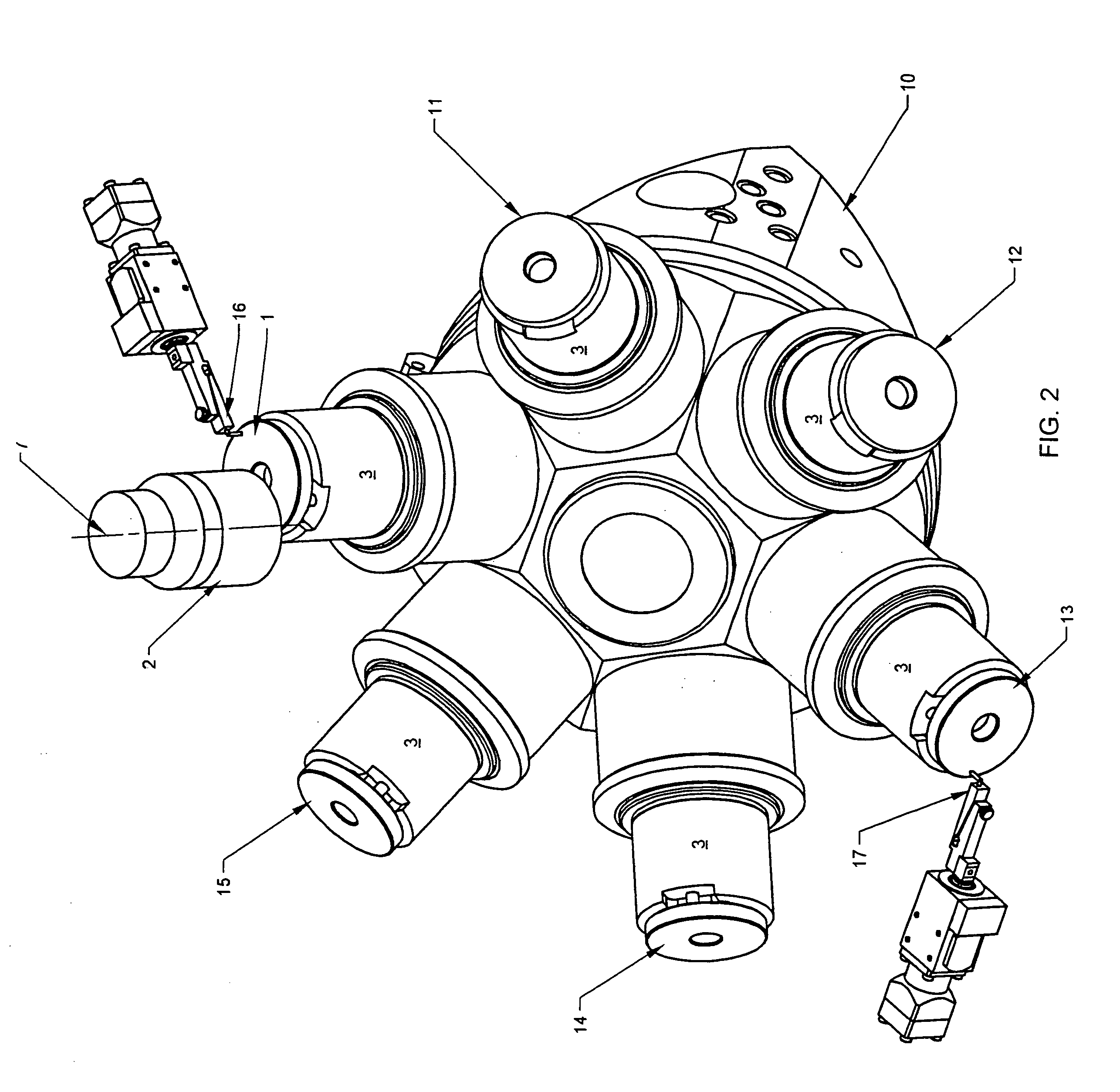Superfinishing machine and method
- Summary
- Abstract
- Description
- Claims
- Application Information
AI Technical Summary
Benefits of technology
Problems solved by technology
Method used
Image
Examples
first embodiment
[0048]FIG. 2 shows a superfinishing apparatus having a set of chucks 3 mounted on respective spindles of a turret 10. In this arrangement, the superfinishing operation can proceed simultaneously with loading and unloading, and / or a gauging process may be conducted prior to, during an intermediate step, or after the process, by a gauge 17 located in conjunction with a workpiece 13 in a non-machining chuck, without unduly reducing process throughput. Of course, gauging may also be conducted in-process by a gauge 16 located in conjunction with a workpiece 1 in a machining chuck. Thus, the superfinishing process may proceed while secondary operations are performed at different turret stations.
[0049] The preferred turret is a Pibomulti 256, 356, or 358, which provides a single electrical servomotor to both position the turret and drive the spindle in at single turret location. The turret 10 permits loading and unloading through a hydraulically clamp at a single position.
[0050] As shown...
second embodiment
[0057]FIG. 5 shows a second embodiment of the invention in which multiple turret 10 locations correspond to different processing operations, allowing the superfinishing machine to perform a plurality of different processing operations on different workflows without additional changeover.
[0058] This embodiment is structurally similar to the first embodiment shown in FIG. 2, except perhaps that multiple flows of workpieces 41, 42, 43, 44, 45, 46 may interact with the turret 10, to load and unload the respective chucks. However, from a control standpoint, this embodiment is somewhat different.
[0059] In prior systems, control complexity was limited by providing a system which was set up and run to perform a single operation. The cup wheel 2 and workpiece 1 each rotated about a defined axis, and the control used its process parameter sensor or a position sensor to initiate contact. Thereafter, the process was controlled to produce a finish on the workpiece with the desired parameters, ...
third embodiment
[0063]FIGS. 6A, 6B and 6C show a third embodiment of the invention in which a single workpiece 1 is processed on different surfaces 1′, 1″ with respectively different processing parameters while mounted in the same chuck 3. In this case, the control employs respectively different control parameters, if for nothing else, to define the offsets A, B of the various surfaces to be treated, but likely also in-process conditions as well. Accordingly, during processing, the control causes the cup wheel 2 to contact a first surface 1′ and applies a respective treatment, until completed. After the first surface 1′ is treated, a second processing program is triggered which then realigns the axes 7, 8 of the cup wheel 2 and workpiece 1. In some instances, the cup wheel 2 is replaced with a different abrasive, appropriate for the subsequent operation. Using the next set of processing parameters, the subsequent surface 1″ is treated. These sequential operations, calling sequential sets of control...
PUM
| Property | Measurement | Unit |
|---|---|---|
| Depth | aaaaa | aaaaa |
| Height | aaaaa | aaaaa |
Abstract
Description
Claims
Application Information
 Login to View More
Login to View More - R&D
- Intellectual Property
- Life Sciences
- Materials
- Tech Scout
- Unparalleled Data Quality
- Higher Quality Content
- 60% Fewer Hallucinations
Browse by: Latest US Patents, China's latest patents, Technical Efficacy Thesaurus, Application Domain, Technology Topic, Popular Technical Reports.
© 2025 PatSnap. All rights reserved.Legal|Privacy policy|Modern Slavery Act Transparency Statement|Sitemap|About US| Contact US: help@patsnap.com



